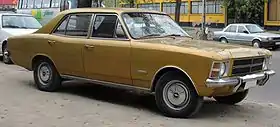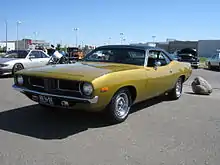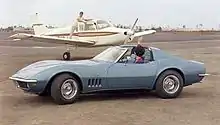Coke bottle styling
Coke bottle styling is an automotive body design with a narrow center surrounded by flaring fenders[1] which bears a general resemblance to a Coca-Cola classic glass contour bottle design.[2] It was introduced by industrial designer Raymond Loewy on the radical 1962 Studebaker Avanti gran turismo.

The design was pioneered in fighter jets as a way of greatly reducing the sharp drag rise that occurs at transonic speed and supersonic speeds. Using this design often results in a pinch-waisted fuselage shape that National Advisory Committee for Aeronautics (NACA) labeled the design principle 'area rule,' and variously identified as coke bottle, wasp waist, or Marilyn Monroe shape.[3][4] The area rule design technique is most effective between Mach 0.75 and 1.2, or at speeds in excess of 575 mph (925 km/h). The design technique on automobiles provides a visual attraction but neglible performance improvement.[5]
Development

The exotic shapes of early supersonic fighter jets had a dramatic influence on automobile stylists. First the tailfin fad, which appeared in the mid-1950s and was on the decline by the early 1960s, then the "Coke bottle" look of severely wasp-waisted high-performance jet fighters such as the Northrop F5.[6] The initial result was luxury performance automobiles, such as the 1962 Studebaker Avanti and 1963 Buick Riviera, which vaguely resembled bottles of Coca-Cola laid on their sides".[7]
United States
Studebaker introduced the Raymond Loewy-designed Avanti gran turismo with pronounced Coke bottle look in 1962.[8] The 1962 Pontiac full-size models also "had a subtle horizontal crease about halfway down [the bodyside] and a slight wasp-waist constriction at the doors which swelled out again in the rear quarters"[9] One of the cleanest examples of the “Coke bottle” styling was the 1963 Buick Riviera,[10] a pioneering personal luxury car. Chevrolet first applied the Coke bottle look on Bill Mitchell's 1963 Corvette Sting Ray.[11]
By 1966, the General Motors A-body sedans received a mid-riff pinch and "hop up" fenders. Intermediates such as the Pontiac Tempest, Dodge Charger, and Ford Torino soon followed suit, as well as compacts such as the Ford Maverick and Plymouth Duster. General Motors also styled their "B" body full-size cars from 1965-68 with this style, which is most prominent on the "fastback" 2-door hardtop models. Chrysler's "interpretation of the Coke-bottle styling treatment to its struggling B-body cars ... [resulted in] ... smooth lines, subtly rounded curves, and near perfect proportions."[12] Notable automobiles with this style include many of the muscle cars during this era, such as the Pontiac GTO, Chevrolet Camaro, and Dodge Charger.[2]
Design "themes" such the "hop up" fenders became so pervasive across the industry that American Motors' all-new 1967 Rebel was criticized because "viewed from any angle, anyone other than an out-and-out car buff would have trouble distinguishing the Rebel from its GM, Ford, and Chrysler Corp. competition."[13] Moreover, AMC discovered that compared to slab styling with deeply sculpted ridges, "the rounded "Coke-bottle" panels would be easier to make and the dies would last longer — an important cost consideration."[14]
Author Clinton Walker described the archetypal product of Australian suburbia, the muscle car, with its "Coke bottle hip bump but the bare midriff of a go-go dancer?"[15] According to automotive historian Darwin Holmstrom, Chevrolet "took it to its illogical extreme with the 1968 Corvette, though that car more closely resembled a prosthetic phallus than a Coke bottle".[16]
By the late-1970s and early-1980s, cars like the Ford Fairmont and Chrysler K-cars moved towards straight lines. The Audi 5000 and Ford Taurus led towards functional aerodynamic styling.
International markets
This styling "was to be seen right across the marketplace and, before long, around the world".[10] Japanese, European, and Australian automobiles also adopted this style during the 1970s. Japanese automaker Nissan offered this appearance on 1970s era Nissan Cedrics, Nissan Glorias, Nissan Laurels, Nissan Bluebirds, and Nissan Violets. Toyota also offered this appearance on the 1972-1976 Toyota Corona Mark II, the limited production sportscar called the Toyota 2000GT, and the Toyota Celica. Mitsubishi also adopted this appearance on the 1973-1980 Galant, and the 1973-1979 Lancer. The smallest car with this style is usually considered to be the 1967 Suzuki Fronte 360, which was less than 3 m (10 ft) long,[17] while the Subaru 360 also used similar styling elements, notably the curvaceous "belt line". The appearance was even used in popular culture in the Japanese anime Speed Racer's Mach 5.
Not all cars displayed the full "plan-view" Coke bottle styling, with the waist narrowing. Some of them, like the British Ford Cortina Mark III achieved a similar look in their profile with the front wing curving up over the front wheel area and a much more pronounced curve over the rear wheel arch.
Automotive examples
- AMC Ambassador (1967-1969) [18]
- AMC Javelin (1968-1974) [19]
- AMC Marlin (1967) [18][20]
- AMC Rebel (1967-1969) [18][21]
- Chevrolet Corvair (1965–1969) [22]
- Chevrolet Impala (fourth generation) (1965–1970) [23]
- Studebaker Avanti (1963-1964) [24]
Gallery
 The 1963 Buick Riviera is regarded as an exceptional example of Coke bottle styling.
The 1963 Buick Riviera is regarded as an exceptional example of Coke bottle styling.




 Ford Mustang (1970 Boss 302)
Ford Mustang (1970 Boss 302)
 1972 Mazda Luce
1972 Mazda Luce

 1970 Toyota Celica
1970 Toyota Celica
 The third-generation Chevrolet Corvette, which made its debut in 1968, is an extreme example of Coke bottle design.
The third-generation Chevrolet Corvette, which made its debut in 1968, is an extreme example of Coke bottle design._jm20695.jpg.webp) The Lamborghini Miura P400 gran turismo was introduced in 1966.
The Lamborghini Miura P400 gran turismo was introduced in 1966. The 1971 Chrysler Australia's Valiant Charger demonstrated that Coke bottle styling appeared throughout model and price ranges.
The 1971 Chrysler Australia's Valiant Charger demonstrated that Coke bottle styling appeared throughout model and price ranges.
References
- "Plymouth Belvedere and Plymouth Satellite: 1968 coke-bottle restyling". allpar.com. Retrieved 30 March 2016.
- Breitenstein, Jeff; Paiva, Troy (2004). Ultimate Hot Rod Dictionary: A-Bombs to Zoomies. MBI Publishing. p. 53. ISBN 978-0-7603-1823-2. Retrieved 30 March 2016.
- Algeo, John, ed. (1993). Fifty Years Among the New Words: A Dictionary of Neologisms, 1941-1991. Cambridge University Press. p. 146. ISBN 978-0-521-44971-7. Retrieved 30 March 2016.
- Heversi, Dennis (25 October 2009). "Richard T. Whitcomb Is Dead at 88; Revolutionized the Design of Jet Aircraft". The New York Times. Retrieved 30 March 2016.
- "What are some advantages over "coke bottle styling" in cars? Is it more aerodynamic than other styling?". Quora. Retrieved 4 February 2021.
- Shenk, Bill (May–June 1995). "The Birth of the 1970 Ford Fairlane/Torino". The Fairlaner News. Retrieved 30 March 2016.
- Holmstrom, Darwin (2016). American Muscle Cars: A Full-Throttle History. Motorbooks. p. 130. ISBN 9780760350133. Retrieved 30 March 2016.
- Jedlicka, Dan. "1963-64 Studebaker Avanti". Retrieved 30 March 2016.
- Wilson, Paul Carroll (1976). Chrome dreams: automobile styling since 1893. Chilton. p. 269. ISBN 978-0-8019-6352-0. Retrieved 30 March 2016.
- Car: The Definitive Visual History of the Automobile. DK Publishing. 2011. p. 186. ISBN 9780756689384. Retrieved 30 March 2016.
- Mueller, Mike (2002). Chevelle. MotorBooks. p. 59. ISBN 9780760314845. Retrieved 30 March 2016.
- Leffingwell, Randy; Holmstrom, Darwin (2006). Muscle: America's Legendary Performance Cars. MBI Publishing. p. 229. ISBN 978-0-7603-2284-0. Retrieved 30 March 2016.
- Kilpatrick, Bill (October 1966). "1967: The Showdown Year". Popular Mechanics. 126 (4): 101. Retrieved 30 March 2016.
- Mitchell, Larry (2000). AMC Muscle Cars. Motorbooks. pp. 31–32. ISBN 9780760307618. Retrieved 30 March 2016.
- Walker, Clinton (2009). Golden Miles: Sex, Speed and the Australian Muscle Car (Revised ed.). Wakefield Press. p. 42. ISBN 9781862548541. Retrieved 30 March 2016.
- Holmstrom, p. 130.
- Ozeki, Kazuo (2007). Suzuki Story: Small Cars, Big Ambitions (in Japanese). Miki Press. p. 30. ISBN 978-4-89522-503-8.
- Quella, Chad. "The Spirit Is Still Alive: American Motors Corporation 1954-1987: 1967". allpar.com. Retrieved 9 January 2020.
Rebel, Marlin and the new, larger Ambassador wore sleek "Coke bottle" styling that was the fad at the time.
- Strohl, Daniel (July 2005). "Attack of the Welterweight". Hemmings Muscle Machines. Retrieved 9 January 2020.
... in profile, it had a real Coke-bottle effect.
- Flammang, James M. (1994). Chronicle of the American automobile: over 100 years of auto history. Publications International. p. 424. ISBN 9780785307785. Retrieved 9 January 2020.
'coke bottle' fender lines of the Ambassador and AMC's fastback Marlin looked miles better for 1967, thanks to curvy new lower-body line
- Cranswick, Marc (2012). The cars of American Motors: an illustrated history. McFarland. p. 73. ISBN 9780786446728. Retrieved 9 January 2020.
Coke-bottle styling was being used on cars everywhere; AMC was staying abreast of fashion and came up with their first family car with style that rivaled function.
- Cheetham, Craig (2006). Ultimate American Cars. MotorBooks/MBI. p. 74. ISBN 9780760325704. Retrieved 30 March 2016.
...with smooth Coke-bottle contours...
- "1967 Chevrolet Impala". oldride.com. Retrieved 9 January 2020.
The Impala was redesigned and had a "coke bottle" shape that similar to the 1963 Buick Riviera.
- Auto Editors of Consumer Guide (17 December 2007). "1963-1964 Studebaker Avanti". auto.howstuffworks. Retrieved 9 January 2020.
A coke-bottle waist formed the base for a thin-section roof with a huge rear window and a built-in rollbar.